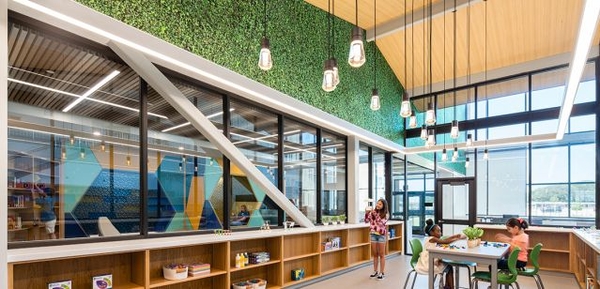Trauma-sensitive design can create safety and comfort, essential for learning.
Erin Peavey
Designed for Happiness
"KEY POINTS
Children with adverse childhood events may have increased sensitivities and struggle to self-regulate.
Thoughtfully designed school environments can help children soothe themselves and cope with triggers.
Trauma-informed design can help all children—not just those who have undergone trauma.
"Childhood can be hard even in the best of times. Children are inherently at a power disadvantage, still learning how to manage their emotions, and at the will of adults for food, shelter, and emotional regulation. Frustration, failure, and conflict are unavoidable, but not necessarily bad for children in the long run.
"But children today face some uniquely difficult conditions, from school shootings (or the threat of them), to the looming threat of climate change, to the pandemic uprooting their sense of structure, control, and predictability. The accumulation of these overwhelming events, occurring on a regular basis—not to mention the additional very real challenges that many children face at home—could contribute to what some call “small T-trauma” (a term I admittedly don’t love). This can in some cases alter the structure of a child’s brain to be hyper-alert to attempt to control their environment or avoid future pain....
Designing Places That Are Trauma-Informed
"Humans spend approximately 90 percent of our time indoors—meaning that the built spaces we inhabit have an outsized impact on our lives. The places where we spend our days can offer wonderful ways to soothe us and help people cope with triggers—or they can exacerbate existing struggles and make it even harder for people to feel OK.
"Trauma-informed design is a design process intended to help people regulate their bodies and minds to support the processes and practices that take place within the building. It can be applied to therapeutic spaces but also schools, workplaces, homes, and beyond.
"Trauma-sensitive design is a step towards normalizing self-regulation as a part of coping with stressful environments. Trauma-informed design can benefit most people, not just those who have been traumatized, since its principles are rooted in evolutionary psychology and the biology of human well-being. Although it will likely be years or decades before we fully understand how the pandemic, climate change, and ongoing school shootings have affected today's children, there are many who believe the need for trauma-informed design will only increase in the coming years.
"Here, I'll focus on schools and other places of learning for children, from early childhood to high school. I'll outline six core themes to consider when designing spaces with a trauma-informed approach, based on the trauma-informed principles defined by The Centers for Disease Control (CDC) and Substance Abuse and Mental Health Services Administration (SAMHSA), as well as specific evidence-based design strategies and examples to help any parent, teacher, school administrator, designer, loved one, or community member advocate for schools that support the mental well-being of children. It’s my hope that this article helps explain what trauma-informed design means, why it matters, and how it can be used in schools."
Click here to read more about how to design trauma-informed schools.
References
Note: For more detailed information, refer to the full Trauma Informed Design Evaluation Tool for K-12 Schools.
National Center on Safe Supportive Learning Environments. Home | National Center on Safe Supportive Learning Environments (NCSSLE). (n.d.). https://safesupportivelearning.ed.gov/; Building Trauma-Sensitive Schools Handout Packet (Pilot), https://safesupportivelearning...out%20Packet_ALL.pdf
Trauma Informed Design Society. (2022). Trauma-informed design evaluation tool for K-12 schools. Retrieved from: https://traumainformeddesign.o.../TiDEvalK12-Tool.pdf on August 01, 2023





Comments (0)